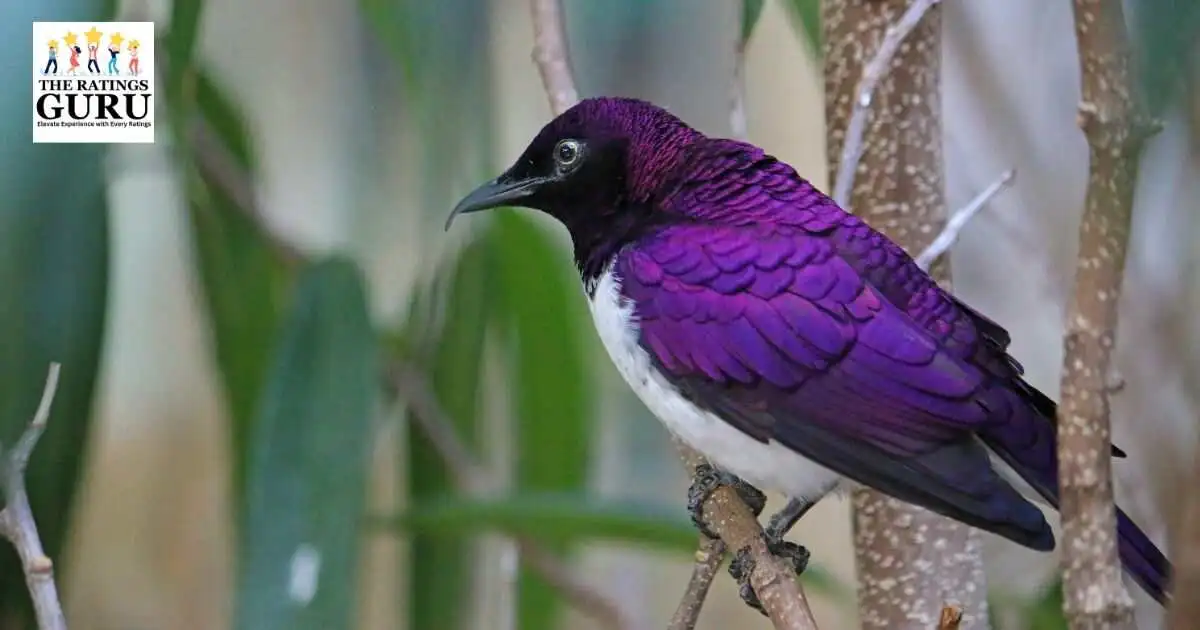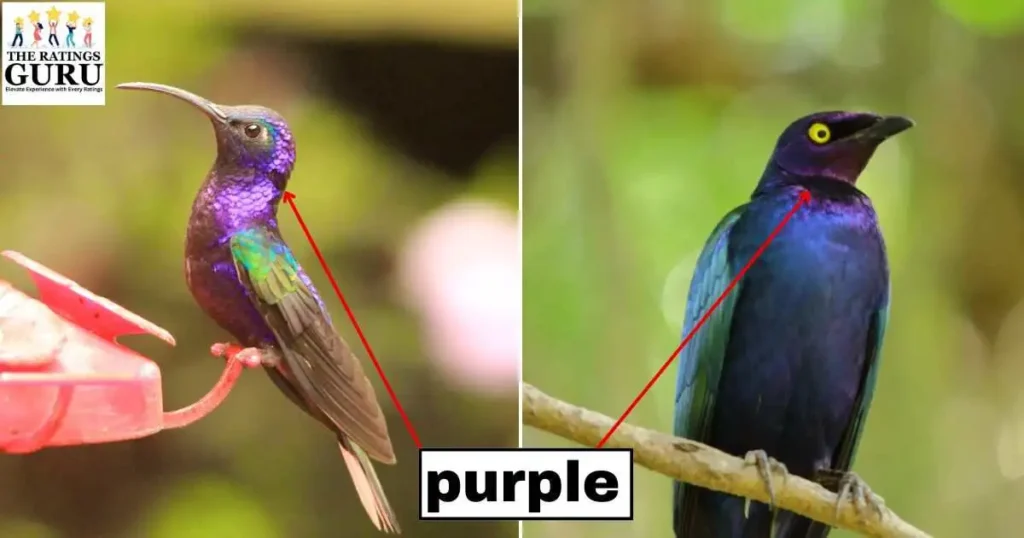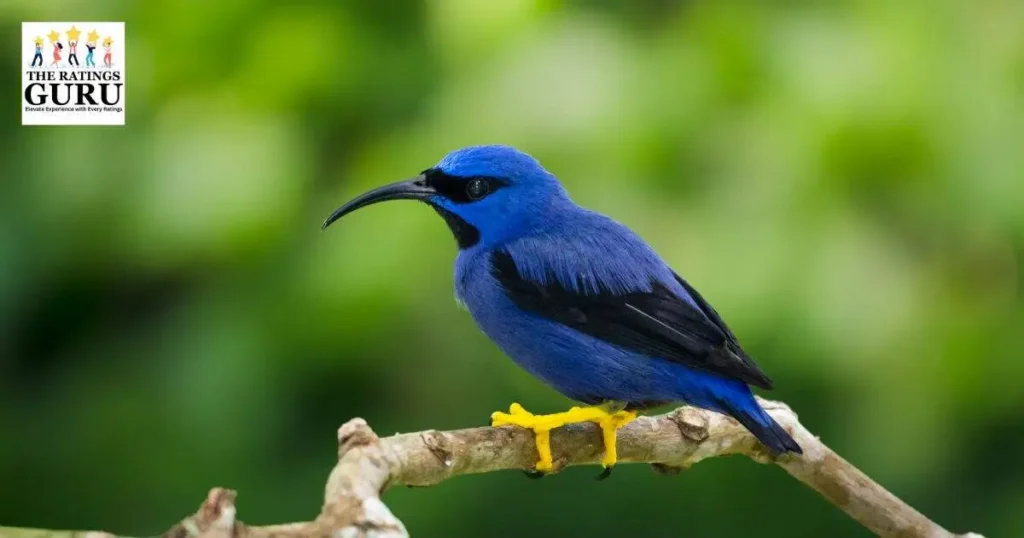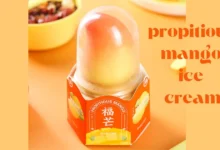The Fascinating World of Purple Birds: Discovering Nature’s Colorful Gems

Purple birds are fun to watch because they are beautiful. Wildlife and bird lovers have been interested in them for a long time. These critters are very pretty. Their feathers are very pretty in this piece because of some interesting facts about them. Purple Birds says where they live, too.
Which bird is purple?

Its scientific name is Haemorhous purpureus. The purple bird is easy to spot because of its purple color. Despite its name, the purple coloring is most noticeable in males during the breeding season. Their heads and backs are bright raspberry red, and their undersides are a softer pink. Even though the females don’t have the bright purple feathers, their brown and white spotted feathers still make them look pretty. It lives in forests and cities all over North America. It looks even better with their bright colors.
The Lifespan of Purple Birds
Purple birds’ life spans can be different based on the species, its habitat, and other factors. Smaller birds often have shorter lifespans compared to larger ones. For instance, Purple Finches typically live 3 to 6 years, whereas larger species like Purple Gallinules can live 7 to 9 years. These estimates are based on available data but factors like disease, predation and environment can alter lifespans. Exact numbers are challenging due to limited knowledge about certain species. We love the way purple birds look, and their short lives make us think about how fragile life is in the wild.
The Allure of Purple Feathers
The bright feathers of purple birds completely mesmerize anyone who looks at them. Their feathers’ many violet, lavender, and blue shades make them stand out among birds. Pigments called carotenoids and melanins are mainly responsible for these beautiful colors.
Habitats and Diversity
Purple birds live in many places around the world, from wet jungles to deserts. It’s amazing how different these bird types are because they have all changed to fit their environments. The purple finch lives in North America, and the purple sandpiper lives along the coasts. Each of these birds has found its place in its environment.
Types of Purple Birds
Take a birding expedition with us as we explore the fascinating world of purple birds. These fantastic birds of prey fill the skies with shades of magenta, indigo, and violet, whether they are found in deserts or lush rainforests.
Purple Honeycreeper Bird

Venture into the tropical forests of Central and South America to encounter the exquisite Purple Honeycreeper. Purple honeycreepers have iridescent plumage and slender bills; this tiny gem dazzles with its jewel-like appearance.
Purple Martin Bird
Fly across the skies of North America to witness the aerial acrobatics of the Purple Martin Bird. Admire its deep purple-blue plumage and melodious songs as it migrates across vast distances each year.
Purple Heron Bird

Wade through the wetlands of Europe, Africa, and Asia to observe the majestic Purple Heron. With its slate-purple feathers and dagger-like bill, this elegant bird epitomizes grace and poise in its watery domain.
Purple-naped Lory Bird
Travel to Indonesia and Papua New Guinea’s lush rainforests to explore the vibrant world of the Purple-naped Lory—Marvel at its vibrant plumage, adorned with splashes of purple, red, and green.
Purple Grenadier Bird
Inhabitants of the African savannas, these petite finches sport a striking purple head contrasting with a chestnut back. Purple Grenadier’s vibrant plumage adds a pop of color to the grasslands they call home.
Purple Roller Bird
Found in the woodlands and savannas of sub-Saharan Africa, Purple Rollers exhibit iridescent shades of purple and blue. Their aerial displays and melodious calls make them a sight and sound to behold.
Purple-crowned Fairy Bird
Native to the cloud forests of South America, these diminutive hummingbirds enchant with their shimmering purple crowns. The purple-crowned Fairy’s delicate appearance belies its fierce territorial nature.
Purple Gallinule Bird
Residing in marshes and wetlands, Purple Gallinules flaunt vibrant purple and azure feathers. Purple Gallinule’s striking appearance and loud calls make them a standout feature of their aquatic habitats.
Purple Finch Bird
The purple finch, often found in North American woodlands, sports a beautiful plumage that ranges from rosy pink to deep purple. These songbirds are a delight to birdwatchers and play a vital role in local ecosystems by dispersing seeds.
Purple Cardinal Bird
Although less well-known than their red counterparts, purple cardinals bird are a rare sight in the wild. These birds display a stunning mix of violet and red, making them a prized find for birdwatchers.
Cultural Significance of Purple Birds
Embark on a journey through time and culture, we unravel the mystical allure of purple birds. People have been fascinated by Purple Bird’s feathered wonders for hundreds of years, from ancient myths to current interpretations.
Ancient Cultures
There was a lot of deep meaning in seeing purple birds because they were a part of mythology, faith, and symbols. Let’s learn more about what they did in old societies:
1. Mythology and Symbolism:
People all over the world in the past gave purple birds mythological meanings and attributes, seeing them as holy or symbolic. For example:
Egyptian mythology: the ibis, with its sleek and distinctive shape, was revered as the earthly manifestation of Thoth, the god of wisdom, writing, and magic. The ibis stood for divine understanding, intelligence, and the ability to change things.
The phoenix: In Greek, Roman, and Egyptian mythology, the phoenix was a very important bird linked to life and renewal. With its beautiful purple and gold feathers, the phoenix symbolizes the cycle of life, death, and rebirth. People thought that it would burn up in flames and rise from the ashes, representing endless life and rebirth.
2. Religious Significance
Purple birds also held religious significance in ancient spiritual practices, serving as messengers of the divine and embodiments of sacred virtues:
Hindu mythology: the peacock was closely associated with various deities, particularly Saraswati, the goddess of wisdom, learning, and the arts. The peacock’s bright feathers stood for beauty, grace, and safety, and the bird’s ability to shed and grow new feathers stood for renewal and change.
Chinese mythology and folklore: the mythical Fenghuang, often depicted with vibrant purple and crimson feathers, symbolized harmony, prosperity, and the union of yin and yang. The Fenghuang was seen as a sign of good luck and wealth because it was the king of all birds and brought peace and plenty.
In many old cultures, purple birds were more than just animals. They were seen as divine beings who embodied eternal virtues and cosmic forces. In mythology, sacred artifacts and symbolic images were a link between the physical and spiritual worlds, making people feel reverence, awe, and wonder.
Modern Interpretations
What purple birds mean to people today has changed over time. They are used in new ways in writing, art, pop culture, and environmental activism. Let’s explore how these majestic creatures are interpreted in modern contexts:
1. Popular Culture References
Purple birds continue to captivate imaginations and inspire creativity in popular culture:
Literature: authors often employ purple birds as symbols of wisdom, guidance, and transcendence. For example, J.K. Rowling’s “Harry Potter” series has Fawkes, a beautiful phoenix with bright purple feathers that stands for loyalty, rebirth, and the victory of good over evil.
Film and animation: Purple birds make memorable appearances, enchanting audiences with their beauty and symbolism. Disney’s “The Lion King” introduces Rafiki, a wise and mystical mandrill with purple markings who serves as a spiritual guide and mentor to the protagonist, Simba.
2. Contemporary Symbolism
Beyond entertainment, purple birds hold contemporary symbolism in various aspects of modern life:
Art and Design: Purple birds inspire artists, designers, and creatives with their vibrant colors and elegant forms. Its images are often used to decorate paintings, statues, textiles, and jewelry. Each one is unique and stands for creativity, personality, and the beauty of nature.
Fashion: Purple birds influence fashion trends and aesthetics, appearing on clothing, accessories, and runway designs. Their plumage inspires designers to incorporate shades of purple into their collections, evoking a sense of luxury, mystery, and sophistication.
Environmental Advocacy: Purple birds serve as ambassadors for conservation efforts and environmental awareness. To keep species living and fight climate change, it’s important to protect habitats. They need to be kept safe because they are an essential part of ecosystems. Activists and groups rally around purple birds as signs of hope, strength, and how all living things are linked.
Purple birds have gone beyond their usual roles as religious or mythical symbols to become well-known figures in modern culture. People are still amazed and moved by these beautiful animals, which connect them to the beauty and complexity of nature. They are praised for their writing, art, fashion, and work to protect the earth.
Birdwatching and Conservation
For those interested in observing purple birds in the wild, birdwatching tips and conservation efforts are crucial topics to include. Learn about the best times and places to see these birds and how to help preserve them.
Conclusion
Birdwatchers of all skill levels love purple birds because of their beautiful feathers and graceful flight. Purple birds always amaze us with their beauty and biological value. It lives in such a wide range of places and has such beautiful feathers. The purple bird gives us ideas and reminds us of how beautiful and varied nature is, both as it is and after people have changed it.
FAQs About Purple Birds
Q: Are there actually purple birds in nature?
A: Yes, several species of birds have plumage with purple hues. While they might not be entirely purple, certain parts of their bodies, such as feathers or patches of skin, can exhibit this coloration.
Q: What gives purple birds their color?
A: The purple coloration in birds is often the result of pigments called carotenoids in their diet. These pigments are usually found in fruits, berries, and insects that birds consume. Additionally, structural coloration, caused by the microscopic structure of feathers, can also contribute to purple hues.
Q: Which bird species are known for their purple coloring?
A: Some well-known examples of birds with purple hues include the Purple Gallinule, Violet-backed Starling, Purple Sunbird, Lilac-breasted Roller, and Purple Finch. These birds can vary in the intensity and distribution of their purple coloring.
Q: Do all purple birds look the same?
A: No, not all purple birds look the same. The shade of purple, the distribution of color on their bodies, and other features such as size and shape vary significantly among species. Some birds may have vibrant purple plumage, while others may exhibit more subtle shades.
Q: Are purple birds rare?
A: While purple birds are not extremely common, they are not necessarily rare either. The prevalence of purple coloring in birds depends on factors such as their habitat, diet, and geographic distribution. In some regions, certain species with purple hues may be more common than in others.









